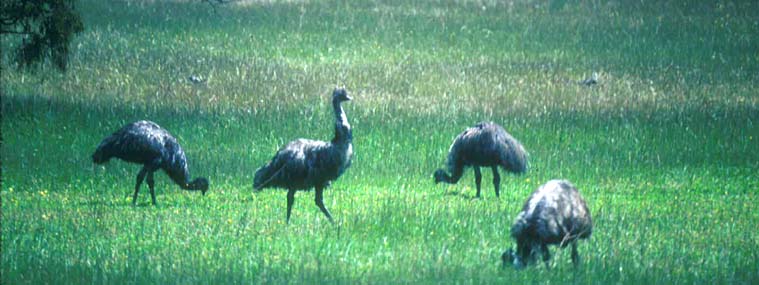 The
Emu is the big, flightless, vaguely ostrich-like bird of Australia. They
are among the oldest bird families on earth, having evolved near the base
of the avian tree of life (see summary in Cracraft et al. 2004). They are
huge birds — as are the other flightless ratites such as the Ostrich of
Africa and the Rheas of South America — and generally inhabit grassy plains
and "open sclerophyll forest . . of the interior" of Australia (Folch
1992). The adult with half-grown youngster (left) is very much in that
"open sclerophyll forest." The
Emu is the big, flightless, vaguely ostrich-like bird of Australia. They
are among the oldest bird families on earth, having evolved near the base
of the avian tree of life (see summary in Cracraft et al. 2004). They are
huge birds — as are the other flightless ratites such as the Ostrich of
Africa and the Rheas of South America — and generally inhabit grassy plains
and "open sclerophyll forest . . of the interior" of Australia (Folch
1992). The adult with half-grown youngster (left) is very much in that
"open sclerophyll forest."
Emus are big, shaggy birds that spend most of their time foraging. They graze on grass and plants much of the day, and gather at waterholes or river edges to drink. They remind me of avian llamas. Although they often forage alone or in pairs, it is not unusual to see groups feeding (below) or at water sources. Yet despite this active grazing, they are omnivorous and will eat large quantities of insects if they come upon them. The breeding strategy of Emu is successive polyandry. Pairing occurs in the southern summer (December-January) when the females start a "drumming" call. The male collects materials for a rudimentary nest and the female lays 5 to 15 eggs therein. After that, it is the male that incubates the eggs and raises the young, although the female may stay in the general vicinity. It takes about five months for the checks to go out on their own. They are born precocial but in need of protection, During this period the male in very aggressive, and may even drive away his mate (Folch 1992). The Emu has along and turbulent history with man. Early white settlers eagerly sought the eggs and appreciated the beef-like flavor of the meat. They have been bred on farms around the world for meat and to use the skin as leather. In 1932 the Australian government, under pressure from farmers who said emus were hurting their crops, sent an army artillery unit to Western Australia. It was planned that 20,000 emus should be killed by using machine guns and grenades. So began the Great Emu War. "However, the birds proved to be more adept in terms of both camouflage and strategic retreat than the soldiers themselves, and they dispersed rapidly in small groups when they were shot at. After a month of endless and fruitless pursuit, during which it is reported that they only managed to kill 12 Emu, the Royal Australian Artillery had to admit defeat and they withdrew. In the wake of this fiasco, the farmers decided to build long, high, Emu-proof fencelines" (Folch 1992). |
 |
|
Emus are more closely related to cassowaries than any other group of birds in the world. There is some evidence (summarized in Cracraft et al. 2004) that the rate of molecular evolutionary change in emus and cassowaries is slower than in other ratites, like ostrich and tinamous. This is just one of the reasons it has been hard to completely figure out that relationships among the Palaegnathae — those basal, ancient families that evolved earliest among modern birds [composed of emu, cassowaries, rheas, ostrich, kiwis, and tinamous]. The extinct moas of New Zealand are also among this ancient lineage. And speaking of extinction, while there is but one species of Emu today
— the Larger or Spotted Emu — there were other species of emu on King Island
and Kangaroo Island, off Tasmania, until early in the 19th century. These
are often lumped together as Dwarf Emu Dromaius baudinanus. There
was another emu on Tasmania that is usually considered a subspecies of
the Larger Emu, but who knows for sure?
|
| Photos: The various Emu
Dromaius nvaehollandiae were photographed in the Grampiens of Victoria,
Australia, in Nov 1983. Photos © 2005 Don Roberson,
all rights reserved.
Bibliographic note There is no family book but this group is covered in standard texts on ratites, and Folch (1992) provides a nice introduction with some fine photos. Literature cited: Folch, A. 1992. "Emu," pp. 98-103 in Handbook of the Birds of the World (del Hoyo, J., A. Elliott, & J. Sargatal, eds). Vol. 1. Lynx Edicions, Barcelona. |